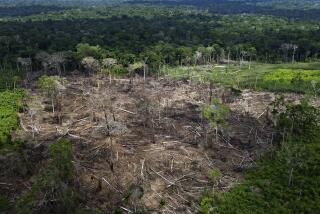Ecuadorean Cloud Forest a Living Textbook for High School Students : Andes: Atlanta school hopes to build an ecological preserve that will attract scientists as well as students to study and to protect a disappearing habitat.
- Share via
ATLANTA — Some of the world’s richest rain forest is shrouded in clouds at the top of Ecuador’s Andes mountains. Here, foot-tall birds and highly endangered bears roam past orchids growing on trees.
A private Atlanta school has bought 320 acres of this cloud forest, hoping to build an ecological preserve that will attract scientists as well as students to study and to protect a disappearing habitat.
“Very little is known about this area,” said Brian Hare, 17, a senior at the Lovett School, who recently returned from a visit to the forest. “It’s in the middle of nowhere, and there’s tons of endangered plants and animals.”
A cloud forest is a mountain rain forest. Lovett students call theirs Siempre Verde-- “forever green” in Spanish.
The name is appropriate because the lush forest lies in the most biodiverse region of the Earth, said Ecuadorean ecologist Fausto Sarmiento.
“It’s a very small piece of land but it has a very high biological value,” he said. “It is important that it stays pristine.”
The Andean village of Santa Rosa and the Lovett School started their relationship in 1990, when science teacher Robert Braddy, hiking on his way to the cloud forest, came upon the small community, about 120 miles northwest of Quito, the capital.
The next year, his students raised $1,800 to rebuild a school in the village of about 200 people. They insisted that the local carpenter not clear-cut for the wood and replant the felled trees immediately.
Then the students decided to preserve some cloud forest, 7,000 to 8,500 feet above sea level, which is being destroyed by farmers who clear-cut new patches for their crops each year.
“It’ll take 150 to 300 years for the forest to grow back, if ever,” Hare said. “You can’t blame them--they’ve got to live.”
A Santa Rosa farmer agreed to sell the plot last year for $7,500; students sold pizzas for $25, among other things, to raise the money. The farmer’s son now acts as caretaker while the school works with the Catholic university in Quito to build a research station.
The plan is for scientists to study Siempre Verde, where 15 endangered species have been found so far, and for Lovett students and alumni to visit as eco-tourists.
Students will plant a garden, in a natural pasture in the forest, to feed visitors. And they will help villagers find new ways of feeding themselves without clear-cutting, perhaps by setting up trout farms or promoting eco-tourism.
Ecologists say it’s rare for students to attempt such hands-on work, and warned them not to become imperialist.
“Ecuador is not a real primitive place,” said Dr. Eugene Odum, a University of Georgia professor known as the father of ecology. “We all tell them we should preserve these things, but the real truth is the poor people have no other option but to cut it down and grow food.”
“But if the money from the tourism goes directly to local villagers, that is a very good approach,” said Sarmiento. “We’ll have to wait . . . to see if this project stands the test of time.”
Lovett, an affluent school that includes grades from kindergarten through high school, has assembled a board to oversee its work at the preserve; members include world-renowned conservationists Mark and Delia Owens, authors of “Cry of the Kalahari.”
In June, students went to see their purchase. They hiked about 16 miles from Santa Rosa, sometimes climbing straight up the steep Andes slopes.
Through the dense foliage they spotted cocks-of-the-rock, highly endangered, foot-tall birds with iridescent red plumage. They also saw signs that someone had been poaching the endangered spectacled bear, prized for body parts said to protect hunters from evil and to heal illnesses.
“We were in virgin forest,” said Holly Crafts, 17. “We were sliding everywhere and bushwhacking our way through some spots. . . . It was amazing.”
Endangered Species
Some of the endangered species spotted in or near Siempre Verde, a 320-acre cloud forest in Ecuador owned by the Lovett School of Atlanta:
* Cock-of-the-Rock: A foot-tall bird with iridescent red feathers that lives on vertical cliffs. Males choose their mates by picking the female that sings the loudest.
* Quepcal: A bird with bright greenish-blue feathers that lives in tree cavities and was used by the original Indian population as a symbol of the cloud forest.
* Yumbo: A toucan with red eyes and a yellow beak with a black stripe; it is important because it disperses the seeds from fruit that feed many of the cloud forest’s animals.
* Spectacled bear: A large bear with shaded eyes that is poached for its meat and because of its mythical powers. Hunters believe that the paws of the bear protect them from evil and that eating its gallbladder gives them the bear’s spirit. The fat is considered a powerful liniment.
Source: Associated Press
More to Read
Sign up for Essential California
The most important California stories and recommendations in your inbox every morning.
You may occasionally receive promotional content from the Los Angeles Times.













